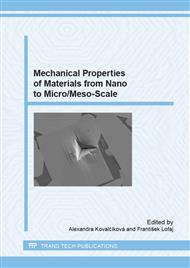p.119
p.123
p.129
p.134
p.138
p.142
p.147
p.151
p.155
Micromechanical Properties of Biocompatible Materials for Bone Tissue Engineering Produced by Direct 3D Printing
Abstract:
Bone implants in form of artificial scaffolds manufactured from poly-lactic acid (PLA) represent an attractive alternative to traditional surgical treatments of defective bones (i.e. autografts and allografts). In this work factors influencing biocompatibility and primary stability of implants manufactured from PLA using direct 3D printing were assessed using nanoindentation. For this reason bulk sample of the PLA material and a printed object were subjected to nanomechanical measurement. Quasi-static nanoindentation was employed to identify elastic modulus and hardness distribution on surface and within volume of the samples. Moreover mechanical properties along scanning direction and interlayer characteristics were also assessed. Gradients in mechanical properties have been identified within volume of the material, within the printing layers and at contact between individual layers.
Info:
Periodical:
Pages:
138-141
Citation:
Online since:
September 2015
Authors:
Price:
Сopyright:
© 2015 Trans Tech Publications Ltd. All Rights Reserved
Share:
Citation:


